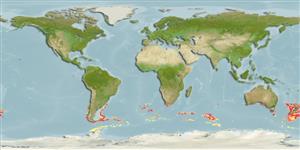Classification / Names
Common names from other countries
Main reference
Size / Weight / Age
Max length : 68.0 cm TL male/unsexed; (Ref. 58312); common length : 40.0 cm TL male/unsexed; (Ref. 9258); max. published weight: 5.0 kg (Ref. 6390); max. reported age: 100 years (Ref. 27140)
Length at first maturity
Lm 40.0 range ? - 41 cm
Environment
Marine; bathydemersal; oceanodromous (Ref. 51243); depth range 400 - 1500 m (Ref. 5194), usually 900 - 1100 m (Ref. 36731)
Climate / Range
Deep-water, preferred 12°C (Ref. 107945); 34°S - 67°S, 90°W - 176°W (Ref. 27159)
Distribution
Southwest Atlantic: off Uruguay to Argentina and the Falklands. Southeast Atlantic: Namibia to South Africa, including the northern part of Walvis Ridge (Ref. 6545). South Pacific: off southern Chile, Bellingshausen and Australian-Antarctic Basin to New Zealand, New South Wales and Tasmania, Australia and the Kerguelen Islands.
Countries | FAO areas | Ecosystems | Occurrences | Introductions
Short description
Dorsal
spines
(total): 5 - 7;
Dorsal
soft rays
(total): 33-36;
Anal
spines: 2-3;
Anal
soft rays: 31 - 34;
Vertebrae: 40 - 43. First dorsal spine longer than second dorsal spine. Opercles fully scaled (Ref. 27159).
Female adult chocolate brown in color with darker fins; prejuveniles silvery with numerous dark spots of various sizes which become larger with age (Ref. 6548).
IUCN Red List Status (Ref. 115185)
Threat to humans
Harmless
Human uses
Fisheries: commercial
Tools
Special reports
Download XML
Internet sources
Estimates of some properties based on models
Phylogenetic diversity index
PD50 = 1.0010 many relatives (e.g. carps) 0.5 - 2.0 few relatives (e.g. lungfishes)
Trophic Level
3.6 ±0.57 se; Based on food items.
Resilience
Very Low, minimum population doubling time more than 14 years (K=0.07; tmax=100; tm=31; Fec=6,000)
Vulnerability
High to very high vulnerability (72 of 100)
Price category
